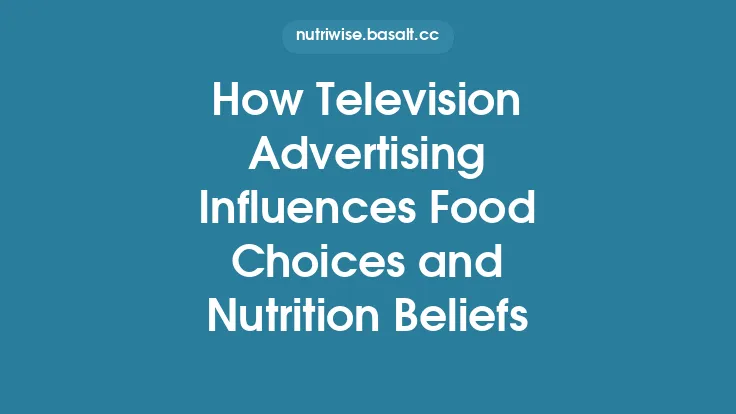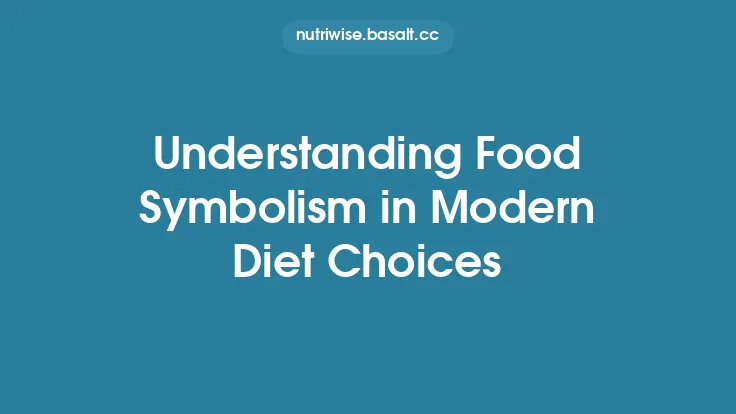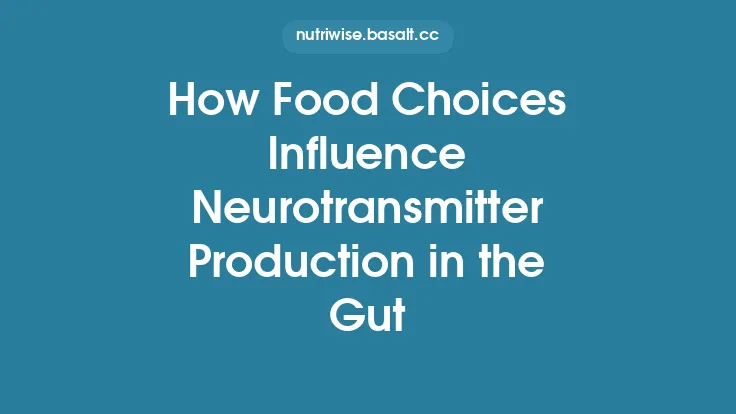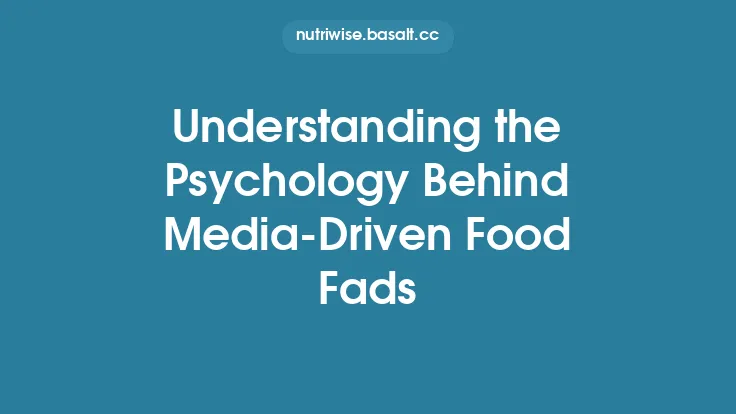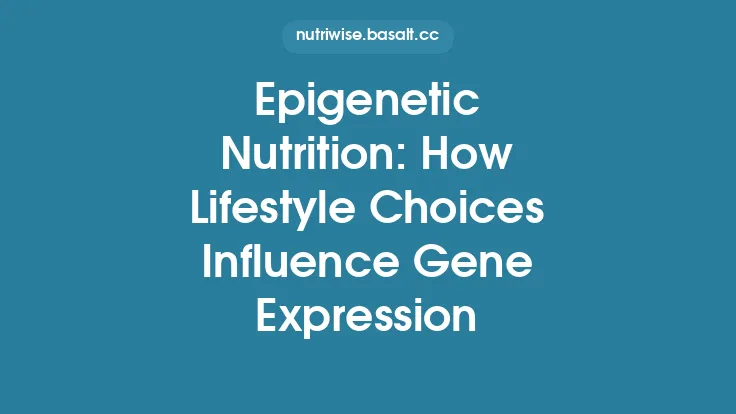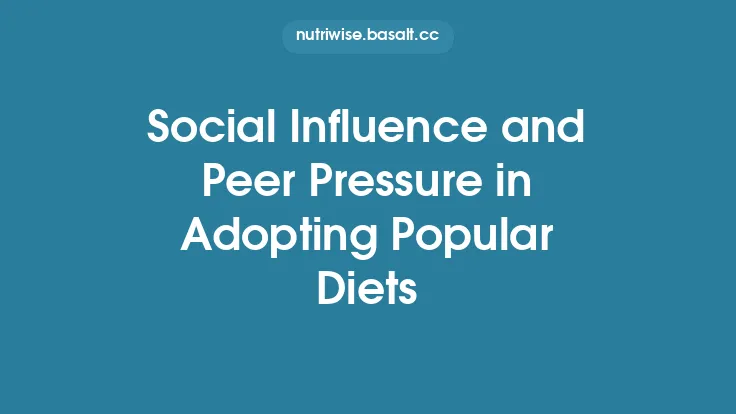Food is far more than a source of calories; it is a powerful symbol that reflects who we are, what we stand for, and how we see ourselves in the world. When we talk about “food identity,” we are referring to the mental map that links personal beliefs, values, and self‑concept to the foods we select, prepare, and consume. This map is built over a lifetime of experiences, cultural exposure, moral reasoning, and health narratives, and it operates largely beneath conscious awareness. Understanding the mechanisms by which personal beliefs shape dietary choices offers a stable, evergreen foundation for both researchers and practitioners who wish to support sustainable, authentic eating patterns.
The Concept of Food Identity
Food identity can be defined as the integration of food‑related attitudes, preferences, and practices into an individual’s broader self‑schema. In psychological terms, a self‑schema is a cognitive structure that organizes information about the self and guides perception, memory, and behavior. When food‑related information is incorporated into this schema, it becomes a “food self‑schema,” influencing how individuals interpret food cues, evaluate options, and justify choices.
Key components of food identity include:
- Belief Systems – Core convictions about what food represents (e.g., “organic food is pure,” “meat is a symbol of strength”).
- Value Hierarchies – Prioritization of ethical, environmental, health, or cultural values that inform food judgments.
- Narrative Coherence – The personal story that links past experiences with present eating habits (e.g., “I grew up on a farm, so I value locally sourced produce”).
- Identity Salience – The degree to which food‑related aspects are central to one’s overall identity (e.g., “I am a vegan” versus “I occasionally eat fish”).
These components interact dynamically, creating a stable yet adaptable framework that guides everyday food decisions.
Personal Beliefs as the Core of Dietary Choices
Beliefs are mental representations of reality that can be factual (e.g., “Vitamin C prevents scurvy”) or evaluative (e.g., “Processed foods are unhealthy”). In the context of diet, beliefs function as filters through which individuals assess food options. Two theoretical lenses help explain this process:
- Health Belief Model (HBM) – Suggests that perceived susceptibility, severity, benefits, and barriers shape health‑related actions. When applied to food, an individual who believes that high sugar intake leads to severe health consequences will be more likely to avoid sugary drinks.
- Theory of Planned Behavior (TPB) – Posits that attitudes toward a behavior, subjective norms, and perceived behavioral control predict intention. Here, personal belief about the moral rightness of animal welfare can shape attitudes toward plant‑based diets, influencing intention and ultimately behavior.
Both models underscore that personal belief, rather than external pressure, is the primary driver of dietary intention when the belief is strongly held and internally endorsed.
Values, Ethics, and Moral Convictions Shaping What We Eat
Values are enduring principles that guide judgments about what is desirable or worthwhile. When values intersect with food, they generate moral convictions that can be remarkably resistant to change. Common value‑driven food identities include:
- Environmental Stewardship – Individuals who prioritize ecological sustainability may adopt low‑carbon diets, such as reducing red meat consumption or choosing plant‑based alternatives.
- Animal Welfare – A belief in the intrinsic rights of non‑human animals often leads to vegetarianism or veganism, framed as an ethical stance rather than a health choice.
- Fair Trade and Social Justice – Consumers who value equitable labor practices may seek out certified fair‑trade products, linking purchasing decisions to broader social concerns.
These value‑based identities are reinforced through moral emotions (e.g., guilt, pride) that act as internal feedback mechanisms, encouraging consistency between belief and behavior.
Cultural and Religious Beliefs as Dietary Frameworks
Culture and religion provide structured belief systems that prescribe, proscribe, or ritualize food consumption. Unlike transient trends, these frameworks are transmitted across generations and are deeply embedded in communal identity.
- Cultural Foodways – Culinary traditions (e.g., Mediterranean diet, Japanese washoku) are expressions of collective heritage. Individuals who identify strongly with their cultural background often view adherence to these foodways as a means of preserving identity.
- Religious Dietary Laws – Rules such as halal, kosher, or Hindu vegetarianism are rooted in theological doctrine. For adherents, compliance is not merely a dietary preference but a manifestation of spiritual commitment.
Because these belief systems are tied to group identity, they tend to be highly salient and resistant to external influence, shaping food choices even in multicultural or diaspora contexts.
Health Beliefs and the Body‑Mind Narrative
Personal health beliefs encompass both biomedical understandings and holistic narratives about the body‑mind connection. Two prevalent health belief patterns illustrate this:
- Biomedical Model – Emphasizes nutrients, caloric balance, and disease prevention. Individuals who adopt this model may prioritize evidence‑based guidelines (e.g., DASH diet) and view food primarily as fuel.
- Holistic Model – Integrates physical, emotional, and spiritual dimensions. Proponents often speak of “clean eating,” “detoxification,” or “food as medicine,” linking dietary choices to mental clarity, energy, and spiritual well‑being.
These health narratives become part of the food self‑schema, influencing not only what is eaten but also how food is prepared, labeled, and discussed within personal discourse.
Identity Consistency and Cognitive Dissonance in Food Choices
When actions conflict with a salient food identity, cognitive dissonance arises—a psychological discomfort that motivates individuals to restore consistency. The mechanisms for resolving dissonance include:
- Behavioral Adjustment – Changing eating habits to align with identity (e.g., reducing meat consumption after adopting a vegan identity).
- Belief Reinterpretation – Modifying the underlying belief to accommodate behavior (e.g., rationalizing occasional cheese consumption as “ethical” because it is locally sourced).
- Identity Re‑prioritization – Lowering the salience of the conflicting identity component (e.g., deemphasizing the “environmentalist” label in favor of a “pragmatic eater” identity).
Understanding these processes helps explain why some individuals persist with diet choices that appear contradictory to their stated beliefs; the internal drive for identity coherence often outweighs external rational arguments.
Narrative Identity: Storytelling and Food
Humans construct personal narratives to make sense of life events, and food frequently occupies a central role in these stories. Narrative identity theory posits that the stories we tell about ourselves shape future behavior. Examples include:
- Origin Stories – “I grew up in a household where fresh vegetables were always on the table; that’s why I value plant‑forward meals.”
- Transformation Tales – “After a health scare, I redefined myself as a ‘clean eater,’ and my meals now reflect that change.”
- Future‑Oriented Scripts – “I envision myself as a long‑living, active grandparent; therefore, I choose foods that support longevity.”
These narratives are not static; they evolve as new experiences are integrated, allowing food identity to adapt while maintaining a coherent sense of self.
Identity‑Based Motivation and Goal Alignment
Motivation that stems from identity—often termed “identity‑based motivation”—differs from generic goal‑oriented drives. When a dietary goal is framed as an expression of who one is, the goal becomes self‑reinforcing. For instance:
- Self‑Labeling – Declaring oneself a “whole‑food enthusiast” creates a mental contract that guides daily choices.
- Goal Congruence – Aligning health objectives with personal values (e.g., “I want to reduce my carbon footprint, so I’ll adopt a plant‑rich diet”) enhances persistence because the goal serves both instrumental and symbolic purposes.
Research shows that identity‑congruent goals are more likely to be internalized, leading to higher adherence and lower dropout rates compared with goals that are purely outcome‑focused.
Dynamic Nature of Food Identity Over the Lifespan
Although food identity can be remarkably stable, it is not immutable. Life transitions—such as moving to a new country, experiencing a health event, or entering a new social role—can trigger re‑evaluation of underlying beliefs. Key factors that facilitate identity evolution include:
- Reflective Processing – Deliberate contemplation of past food experiences and current values.
- Exposure to Novel Belief Systems – Encountering alternative dietary philosophies through travel, education, or media.
- Physiological Changes – Aging, pregnancy, or illness that alter nutritional needs and reshape health beliefs.
These catalysts can lead to either reinforcement of existing food identity (e.g., deepening a vegan commitment) or the emergence of a hybrid identity (e.g., “flexitarian with a focus on sustainable seafood”).
Practical Implications for Practitioners and Individuals
Understanding the centrality of personal belief in food choices offers actionable insights:
- Assessment of Belief Structures – Clinicians and dietitians should explore clients’ core values, cultural/religious frameworks, and health narratives before recommending dietary changes.
- Identity‑Consistent Messaging – Tailor advice to align with the individual’s self‑concept (e.g., framing a Mediterranean diet as “a tradition that honors my Mediterranean heritage” for someone with that cultural background).
- Narrative Re‑authoring – Encourage clients to construct empowering food stories that integrate new behaviors without threatening existing identity.
- Gradual Integration – Introduce changes that complement, rather than contradict, salient beliefs to minimize dissonance (e.g., substituting plant‑based proteins in familiar recipes for a meat‑identifying individual).
- Monitoring Identity Salience – Periodically reassess which aspects of food identity are most central, as shifts may signal readiness for new dietary adaptations.
For individuals, reflective journaling about food‑related beliefs, values, and stories can clarify personal motivations and support more authentic, sustainable eating patterns.
Future Directions in Research
While the link between personal belief and diet is well‑established, several avenues merit deeper exploration:
- Longitudinal Mapping of Belief Evolution – Tracking how specific belief changes correspond with dietary transitions across the lifespan.
- Neurocognitive Correlates of Food Identity – Using neuroimaging to identify brain regions involved in identity‑driven food decision making.
- Cross‑Cultural Comparative Studies – Examining how differing cultural belief systems shape distinct food identities and their resilience to global diet trends.
- Intervention Design Based on Identity Theory – Developing behavior‑change programs that explicitly target identity reconstruction rather than merely providing nutritional information.
Advancing knowledge in these areas will refine our ability to support individuals in aligning their eating habits with their deepest convictions, fostering both personal well‑being and broader societal health.
By recognizing that food choices are fundamentally expressions of personal belief, we move beyond superficial diet trends and toward a nuanced, enduring understanding of eating behavior. This perspective empowers individuals to make choices that are not only nutritionally sound but also deeply resonant with who they are and what they stand for.
